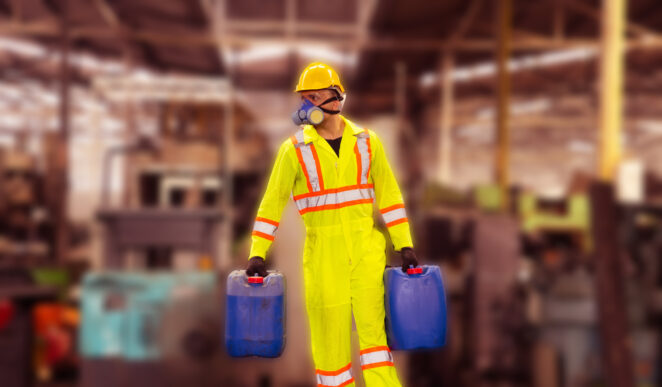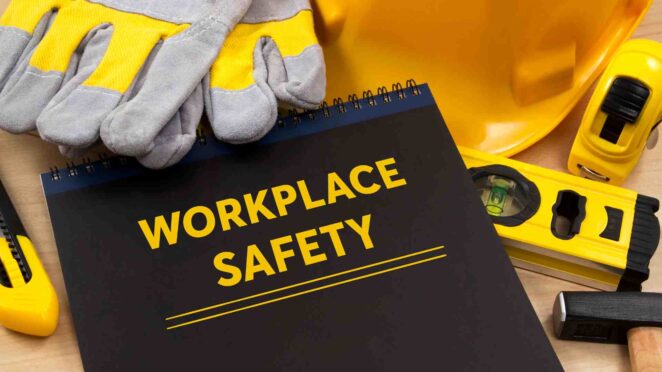Working with dangerous chemicals can be a hazardous endeavor, and it’s important to take the proper steps to protect yourself and your coworkers. There are numerous risks associated with chemical exposure, including skin irritation, respiratory problems, eye damage, and even long-term health issues. Fortunately, there are ways you can stay safe around hazardous materials in the workplace. By following safety protocols and using protective gear such as gloves and respirators when necessary, you can minimize your risk of injury or illness from chemical exposure. In this article, we will discuss how to stay safe around dangerous chemicals at the workplace by outlining some key safety tips for working with hazardous materials.
Wearing Protective Gear
When working with hazardous chemicals, it is essential to wear protective gear such as gloves, safety glasses, respirators, and other protective clothing. This will help to reduce the risk of serious injury or illness from chemical exposure. It is important to always read the manufacturer’s instructions for any product that you are using in order to understand the proper safety protocols for that product. Your employer should provide you with all of the necessary safety equipment for your job. Whether you are in need of gloves, safety glasses, or respirators, it is important to make sure that you are using the right equipment for the job.
Using Appropriate Containers

When working with hazardous chemicals, it is essential to use appropriate containers for the storage and transport of these materials. It is important to always ensure that all containers used by employees are properly labeled in accordance with relevant laws and regulations. For example, containers should clearly indicate the name of the chemical, quantity, hazard rating, and any additional safety information required by law or regulation. These labels are essential for workers to be able to identify which chemicals they are dealing with and take the necessary precautions.
When you pick up a container, make sure that it is in good condition with no cracks or leaks. You should also check the contents of the container to ensure that the chemical inside is compatible with your safety equipment and appropriate for the task you are about to undertake.
Hazardous Chemicals Course Online
If you are an employee who regularly works with hazardous chemicals, it is advisable to take a hazardous chemicals course online. This will provide you with the necessary knowledge and skills to work safely around these materials. For instance, the Online Hydrogen Sulfide h2s certification course is designed to provide workers with an understanding of the hazards associated with hydrogen sulfide, along with the proper safety protocols for working in areas where this substance is present. While taking a course is not always required, it can help to ensure that workers are adequately prepared when dealing with hazardous materials.
While taking a course is not always required, it can help to ensure that workers are adequately prepared when dealing with hazardous materials. You can find a wide range of courses available online, so make sure to research the options available before making a decision. Before starting any job involving hazardous materials, it is important to ensure that you have a full understanding of the safety protocols for working in this environment.
Good Work Practices are Important

When working with hazardous materials, it is important to practice good work habits such as properly labeling and storing chemicals, using appropriate ventilation and containment techniques, wearing protective clothing, avoiding eating or drinking in the work area, and washing your hands after each task. Additionally, be sure to adhere to safety protocols and regulations established by your employer. Knowing these and following them could save your life.
If you’re wondering what to do if something goes wrong, it is always a good idea to familiarize yourself with your workplace’s safety plan. Keep a copy of the evacuation and emergency response plans in an easily accessible place so you can quickly access them in case of an emergency. Additionally, be sure to know where the nearest eyewash station or fire extinguisher is located in case of an emergency. Finally, always report any incidents or near-misses to your supervisor immediately.
Complete a Hazard Assessment
Before beginning any work with hazardous materials, it is important to complete a hazard assessment to identify potential risks associated with the task. This will help ensure that all necessary safety measures are taken to protect employees from exposure to dangerous chemicals. The hazard assessment should include identifying the type of hazardous material being used, the amount of material that will be handled, and the methods of storage and disposal.
Some of the other safety precautions that should be taken include providing adequate ventilation, training employees on the safe use of hazardous materials, and regular maintenance of safety equipment such as respirators and protective clothing. The goal is to ensure that all employees are well-prepared for working with hazardous materials and know what to do in case of an emergency.

Following Rules and Regulations
It is important to adhere to all safety rules and regulations established by your employer, as well as any relevant federal, state, or local laws. For example, workers should be aware of the Occupational Safety and Health Administration (OSHA) HazCom Standard which requires employers to provide information about hazardous chemicals in the workplace. This includes labels on containers, signs informing employees of hazards, safety data sheets, and more. Knowing these rules, regulations, and laws will help ensure that you are working safely with hazardous chemicals in the workplace.
Over a period of time, the risks associated with working with hazardous materials can be greatly reduced by following the best practices outlined above. Although it is impossible to eliminate all risk, being aware of the potential hazards and taking appropriate safety precautions can go a long way towards protecting workers from harm.
In conclusion, it is important to take the necessary safety precautions when working with hazardous materials. By following these tips, you can minimize the risk of injury or illness from chemical exposure and ensure that all employees are well-prepared for working in hazardous environments. Remember to always wear protective gear, use appropriate containers for storage and transport, complete a hazard assessment before beginning work, adhere to safety rules and regulations, and be familiar with your workplace safety plan in case of an emergency. If you take these steps, you can help to keep yourself and your coworkers safe when working with hazardous chemicals at the workplace.




